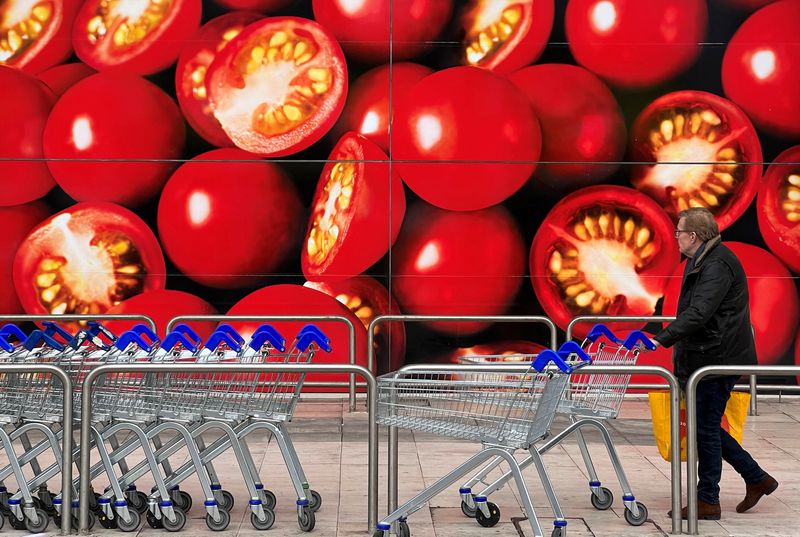
©Reuters. A shopper walks past a photographic depiction of tomatoes in a Tesco supermarket as Britain experiences a seasonal shortage of fruit and vegetables, in London, Britain, February 26, 2023. REUTERS/Toby Melville/file photo
2/2
By James Davey
LONDON (Reuters) – As British shoppers look to increase their spending further each week, supermarket leaders Tesco (OTC:) and Sainsbury’s are using their superior financial firepower to win customers from debt-ridden rivals struggling to to compete.
A recent survey by consumer group Which? found that the two groups outperformed their private rivals Asda and Morrisons on key metrics including store appearance, product quality and stock availability, helping them to sell more goods.
And with Asda and Morrisons both now owned by private equity and saddled with the rising cost of servicing debt, Tesco and Sainsbury’s are looking to take advantage. They are keeping a lid on prices, agreeing to longer deals with suppliers, investing in technology and automation and navigating a still-tight labor market by paying higher wages.
Alex Clifton, 20, a student from the English city of Bristol, remains loyal to Tesco, attracted by its loyalty program.
“Since Tesco increased the prices of Clubcards I haven’t even considered shopping at Asda or Morrisons because not only do you get better quality food but it’s cheaper now too,” he said.
Weekly price data from trade publication The Grocer regularly shows that Tesco and Sainsbury’s are cheaper once savings for Tesco’s Clubcard and Sainsbury’s’ Nectar members are taken into account.
Both schemes are driving volume growth, giving them greater leverage over suppliers. Additional five- and 10-year supplier agreements are resulting in more competitive pricing and further volume growth and consequently even better supplier agreements. Britain’s £230 billion ($295 billion) food market has long been extremely competitive, led by fast-growing German-owned discounters Aldi and Lidl who have forced all other players to cut costs and improve prices for avoid losing customers. In the 12 weeks to February 18, Tesco and Sainsbury’s had a combined 43.2% share of the UK market, up 0.7 percentage points on the year, according to data from market researcher Kantar. Over the same period, Asda and Morrisons fell 0.7 percentage points for a combined 22.6%, continuing a trend seen since they were sold in 2020 and 2021 respectively.
“Morrisons and Asda are private equity owners, they have a lot more debt and, given what has happened to interest rates, they just have less financial flexibility, so they are less able to compete,” said Richard Marwood, head of income at Royal London Asset Management, a top 35 shareholder in both Tesco and Sainsbury’s. Sainsbury’s chief executive Simon Roberts told Reuters last month that now was “the right time to take advantage of the position we are in”. He also told reporters he doesn’t believe many of his rivals can match Sainsbury’s up to 15% increase in capital spending to £2.6 billion in the three years to 2026/27, designed to improve technology , logistics and implementation.
“This is what we believe will increasingly separate the winners from the rest of the industry,” he said. Sainsbury’s has also invested £780m over the past three years to keep prices low in a time of inflation, as has Tesco, matching discounters Aldi and Lidl’s prices on key items. Both Sainsbury’s and Tesco have increased staff pay for 2024 by more than 9%.
FIREPOWER LIMITED
Last month Morgan Stanley picked Tesco as its top pick in European retail for 2024, while HSBC said Tesco and Sainsbury’s were two of its top three picks in European food retail, along with French Carrefour (EPA:), highlighting its scope, cost saving opportunities and ability to increase sales in terms of volume.
This momentum is much harder to imagine for Asda and Morrisons. While all UK supermarket groups will face higher business tariffs and a 10% increase in the government-mandated minimum wage this year, Asda and Morrisons also have to contend with rising interest rates, limiting their firepower.
Private equity group TDR Capital teamed up with brothers Zuber and Mohsin Issa to buy Asda from Walmart (NYSE:) in a 2020 deal that left the US giant retaining a 10% stake. Morrisons was bought by US private equity group Clayton, Dubilier & Rice in 2021.
Both operations were highly leveraged and lending conditions deteriorated significantly, making them appear expensive.
Asda’s parents have faced a £30 million increase in debt costs since February when the fixed interest rate on a sixth of their £4.2 billion debt expired. Finance costs in 2022 were £396 million.
Morrisons ended its 2022/23 year with debt of £5.5 billion, paying interest of around £400 million during the period. While payments in 2023/24 will be lower after using proceeds from the sale of fuel distribution businesses to pay off debts, it will still face a large bill.
Morrisons’ new chief executive Rami Baitiéh has said he is unhappy with the company’s performance and plans a strategy review. Asda is pinning its hopes on a major expansion into convenience stores. But they face a difficult challenge.
“The gap in the food sector is clear and it is difficult to look too far beyond highly indebted businesses and the interests they bring as the reason for laggards,” another British food sector veteran, who wished to remain anonymous, told Reuters. .
($1 = 0.7797 pounds)